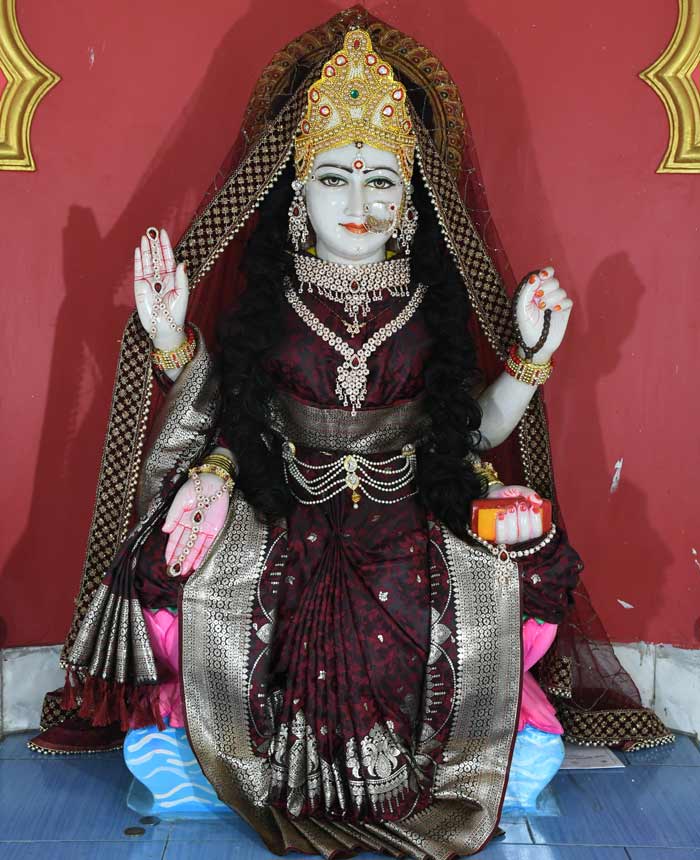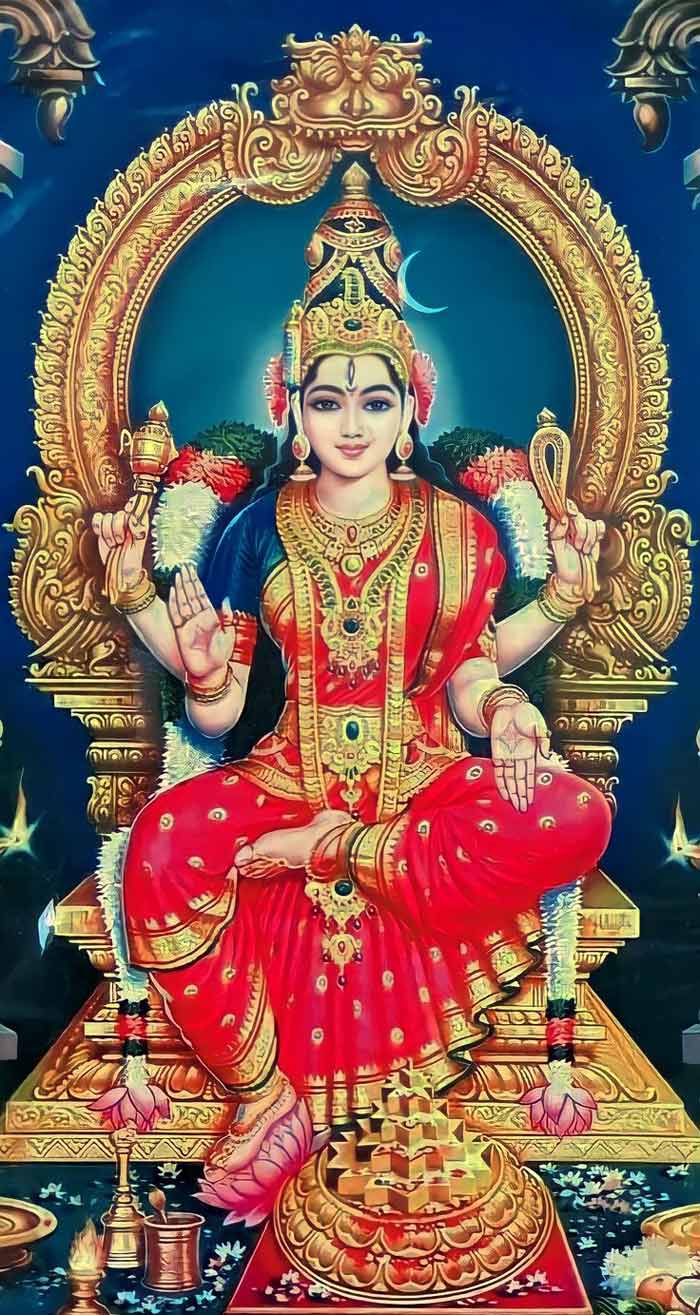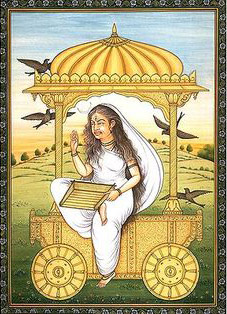The 10 Mahavidyas in the Tantric tradition are:
Maa Kali, Devi Tara, Tripura Sundari, Devi Bhuvaneshvari, Devi Bhairavi, Devi Chhinnamasta, Devi Dhumavati, Devi Bagalamukhi, Devi Matangi, Devi Kamala.

Devi Kali is a Mahavidya and an extremely powerful and fierce form of Shakti.
Kali is derived from the word Kala which has two meanings , time and darkness. She is a personification of time and space; the ultimate structure of the creation. she represents the force of time carrying both destruction and creation of universe.
She is Mother Nature herself –creative, nurturing and devouring. In Tantric tradition Ma Kali’s dual nature leads practitioners to simultaneously understand the beauty of life and its transient nature.
Her lack of clothes signify reality without any illusion.
Her dark colour signifies the eternal void or space from which all creation emerges and where it all finally is absorbed.
Her necklace of severed heads and girdle of severed arms is seen as a metaphor for severance from the bonds of karma and accumulated deeds. Human hands are also considered the primary instruments of work and so signify the action or karma.
The single severed head mother holds signifies the human ego that must be cut off in order to exit from the cycle of life and rebirth.

Devi Bagalamukhi is one of the dasa Mahavidyas and an extremely powerful form of Shakti. Dasa Mahavidyas are the ten aspects of Shakti.
Her name is the combination of Bagala and Mukhi. Bagala, is distortion of the Valga (वल्गा), which means bridle. Hence she is a Goddess who has the power to control and paralyze the enemies. Due to her powers She is also known as Devi of Stambhana (स्तम्भन).
She is the one who has power over the mind and speech. She is called Shatru buddhi vinashini and Brahmastra Rupini. She is considered a Brahmastra herself. She protects her worshippers fiercely and is extremely revered in the tantric tradition.
There is a spiritual perspective- She is the knowledge that stuns anyone into silence. to be stunned into silence is to stop the continuous chatter of the mind. Worshiping Devi Bagalamukhi helps to defeat one’s internal enemies viz. krodh, lobh, moh, ahankar. Sadhaks get inner strength and wisdom to control negative thoughts and energies.
Mata Bagalamukhi destroys the illusions of her devotees to aid spiritual growth. She gives courage and wisdom to fight adversity and adversaries.
She is also known as Pitambari, the goddess associated with golden colour.
Mata Bagalamukhi has a golden complexion wears golden clothes and sits on a golden throne in the Turmeric ocean (Haridra Sarovar).

Devi Tripura Sundari is one of the ten Mahavidyas and is also known as Rajarajeshvari, Shodashi Kamakshi and Lalita. She is revered largely in the Shakta tradition and is widely praised in the Lalita Sahasranama and Saundarya Lahari. In Sanskrit, Tripura means three (tri) cities (pura), and Sundari means a beautiful woman. She is often depicted as a beautiful sixteen-year-old girl, symbolizing eternal youth. Her form is said to be the most beautiful in all the three worlds, a beauty that also expresses the spiritual radiance of the supreme consciousness.
Lalita means “She Who Plays”. All creation, manifestation and dissolution is considered to be a play of Devi.
She represents the transformative power of beauty, which can lead the devotee from the ignorance to enlightenment.
Srimata emerged from the fire of knowledge to protect devs and devotees and slay demon Bhandasura who was born from the ashes of Kamadeva. In the Shakta tradition, she is considered the aspect of the Divine Mother, representing beauty, love and the play of the universe.
The Yantra and Mantra of Goddess Tripura Sundari are profound tools, symbolizing deep spiritual and cosmic significance.
The Sri Yantra is her geometric representation and represents the universe and the interplay of masculine and feminine energies.
The practice of Shodashi sadhana is a journey towards both pleasure and moksha, reflecting the dual nature of her blessings. Goddess Shodashi is revered as a fundamental deity in guiding devotees towards Moksha, the ultimate liberation from the cycle of birth and death.

Devi Tara is a Mahavidya and resembles Ma Kali in appearance. She has both gentle and fierce aspects. Tara means star and as the star she is seen as a beautiful guiding force leading to self awareness.
The origin of Tara Mahavidya is associated with samudra manthan when both Amrit and Halahala came out from the samundra. Lord Shiv drank the halahal or poison to save creation from destruction. However he fell unconscious due its powerful effect. Mahadevi appeared as Maa Tara and fed lord Shiv with her milk counteracting the poison. Lord Shiv got the name Neel kanth and devi tara Neel saraswati.
She is the ‘mahavidya’ of the planet Jupiter signifying that she is connected with knowledge , wisdom and conscious transformation.
She is the source of Nada or cosmic sound and is associated with the power of speech.
Devi Tara as "light" guides in conquering hurdles coming in way of acquiring knowledge. She aids in attaining wisdom and power of effective speech.
Like a star (Tara) burns bright, consuming itself, the articulation of wisdom in humans should consume and burn their ego to attain Moksha (enlightenment).
One hand holds a scissors symbolising her power to cut her devotees slowly from the bondage of life and death.
Devi Tara is said to be found in the fires of smashan symbolising that she releases her devotees of all obstacles and ultimately aids them to attain moksha beyond the cycle of life and death.

Devi Bhuvanesvari is a Mahavidya and is identified with the manifested world and our experience of it. Like Devi Kali embodies time, Devi Bhuvaneshwari embodies the principle of space.
Her name consists of two elements: bhuvana, which means the entire cosmos and isvari, which means the ruler. She is called Mahamaya meaning one whose magical power is great. She is called Sarvarupa (she whose form is all) and Visvarupa meaning who appears as the universe. She rules over the process of cosmic manifestation.
The entire universe, is considered as the body of Devi Bhuvaneshwari. This understanding inspires us to recognise the interconnectedness and reverence for all aspects of creation. She is celebrated as the all-pervading divine presence.
Devi Bhuvaneshwari is often depicted as a beautiful, radiant woman adorned in jewellery with four arms. This beauty may be understood as an affirmation of the physical world. Tantra does not denigrate the material world but accepts all that is.
The creation, with its diversity, is her joyful play, to which she remains observant. That is indicated by her three eyes, which represent her knowledge of past, present and future.
Devi is often shown holding a noose and a goad to illustrate her captivating as well as liberating powers. Devi who binds and Devi who sets free. The noose she holds also symbolizes her power to bind and control forces. The goad she holds represents her ability to guide and direct her devotees on the path of spiritual growth.
As the prime source of energy and the sovereign of the materialistic universe, Mother Bhuvaneshwari creates and sustains space, allowing all beings to thrive until they awaken to their true nature and merge with her.

Devi Dhumavati is one of the dus maha vidya’s and is said to manifest herself at the time of cosmic dissolution (pralaya). She is “the void” that exists before creation and after dissolution. She is a figure of mystery and complexity.
She is often portrayed as old and unattractive. She adorns a white saree symbolic of a widow, her unkempt hair and no-makeup look convey existential reality. Rudrashaka beads is her only shringar. She stands for adversity that serves to build character.
In this light, Dhumavati is the bestower strength.
Devi Dhumavati, is shrouded in smoke, representing the aspects of life associated with renunciation and the corrosive power of time.
Her legend reveals that Devi Kali consumed Lord Shiv to save her devotee and subsequently, assumed the form of the widowed Devi Dhūmavati. Her name translates to "one made of smoke”.
She is often accompanied by a crow which is a symbol of transformation and change, reinforcing the transformative aspects of Devi’s nature.
After death the body is consigned to the funeral pyre, our entire subjective, assumptive universe ends in smoke; hence the power of ultimate destruction is called Dhūmāvatī. She is the shakti that destroys the structure of all things. Nothing is left for her to possess. She is believed to grant her devotees wisdom, detachment and liberation from worldly desires, making her an important figure in the pursuit of spiritual growth and enlightenment.
Devi Dhumavati is worshipped by those who seek to transcend worldly desires and attachments. She represents the critical aspect which clears away the illusions and limitations that prevent us from realizing our true nature. By invoking Devi Dhumavati, one can gain the courage and detachment needed to face life’s challenges and embrace the ultimate reality.

“Chhinna,” meaning “severed,” and “Masta,” meaning “the head.”, “Chhinnamasta” means “the one with a severed head.”
Devi Chinnamasta is celebrated under various names, including Prachanda Chandika, Jogani Maa and Chinnamastika. She is believed to be a fierce form of Devi.
Her imagery is extremely enigmatic, portraying her as a symbol of profound transformation. One of the ten mahavidyas, Devi is represented without clothes signifying renunciation from worldly attachments.
Her left hand holds her decapitated head, which drinks from one of three streams of blood gushing from her severed neck. Her attendants Dakini and Varnini stand on either side, feasting on the other two streams. Her two attendants are symbolic of Ida and Pingala nadis, while her severed head represents Sushumna Nadi. Various interpretations are associated with Devi, however awakening of kundalini shakti is often considered the most appropriate and profound symbolism.
She usually stands or sits on top of Rati and Kamadev, who are engaged in sexual intercourse. This signifies mastering of sexual desire.
The beheading of the goddess represents the elimination of ego, as the head symbolizes one’s ego. To awaken Kundalini Shakti, one must master sexual desires and shed the ego.
The Story from Pranatoshini Tantra
Once, while Devi Parvati, was bathing in the Mandakini river, she experienced a moment of heightened emotion which briefly altered her appearance. Simultaneously, her two attendants Dakini and Varnini, found themselves in the grip of extreme hunger and begged devi Parvati for sustenance. In an act of immense generosity, she willingly sacrificed herself by severing her own head to provide her attendants with her life-sustaining essence. She then reunited her head with her body after her attendants’ hunger was pacified, revealing her divine power and compassion.
The worship of Devi Chinnamasta holds multifaceted significance. It serves as a means to remove obstacles obstructing one’s journey to success, to overcome adversaries and to awaken kundalini shakti within. Additionally, it symbolizes the mastery over one’s own sexual desires, material attachments and ego.

Devi Kamala is a Mahavidya and is considered to be Devi Lakshmi. She is also known as Tantric Lakshmi.
Devi is a form of AdiShakti which grants prosperity, wealth and beauty to her devotees. She is also known as Kamalatmika and eliminates poverty. She brings calm through material luxury.
Kamalam is lotus flower and Kamala is the ‘one, who resides in a Lotus’. She sits in Padmasana in a lotus, she is bathed by four elephants who gently pour nectar over her through their trunks. Devi Kamala remains the personification of infinite beauty and grace. She represents important aspects of physical existence, fertility, prosperity and fortune. She is the Goddess of wealth, and can bless one with both, its physical and spiritual aspects.
Devi Kamala is depicted in red dress and lavishly adorned with golden jewellery. She has a golden complexion and has with four arms. In two arms, she holds lotus flowers and with the remaining two arms, she makes Varada and Abhaya mudra which are boon-giving and being-fearless mudra.
She destroys poverty in every form for her devotees. Her grace can also ease problems like failure, childlessness, misfortune and the malefic effects of planet Venus (shukra). She blesses her devotees with prosperity, abundance and spiritual growth.